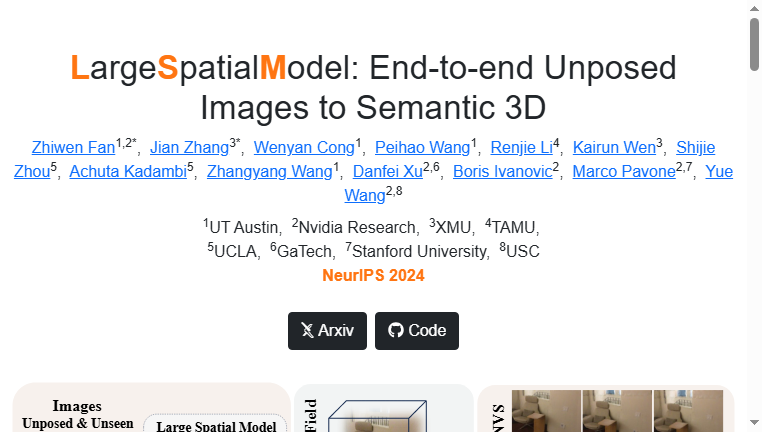LargeSpatialModel (LSM)
LargeSpatialModel (LSM) is a cutting-edge AI solution designed for transforming 2D images into detailed semantic 3D models. It enables users to generate intricate 3D reconstructions in real time from minimal photographic input, eliminating the necessity for complex camera settings. This technology s... Read More
More Detail
LargeSpatialModel (LSM) is a cutting-edge AI solution designed for transforming 2D images into detailed semantic 3D models. It enables users to generate intricate 3D reconstructions in real time from minimal photographic input, eliminating the necessity for complex camera settings. This technology streamlines the process of 3D modeling, making it accessible for various applications, including gaming, virtual reality, and urban planning.
What you can do with LargeSpatialModel (LSM) and why it’s useful
◆Main Functions and Features
・2D to 3D Transformation. LSM can convert simple 2D images into complex 3D models, facilitating the creation of detailed visual content for applications in various fields. This feature dramatically simplifies 3D modeling workflows.
・Real-Time Reconstruction. The tool performs 3D model generation on-the-fly, allowing users to visualize their models while they work. This immediacy aids in creative processes, reducing iteration times.
・Minimal Image Requirements. Users only need a few unposed images to generate comprehensive models, which streamlines the initial input process and makes the tool user-friendly for those without extensive photographic equipment.
・Semantic Understanding. LSM provides semantic tagging during the modeling process, enhancing the contextual relevance of the generated 3D content. This characteristic improves the usability of models in interactive applications.
・User-Friendly Interface. The tool boasts an intuitive interface designed to cater to users of varying expertise levels. This accessibility broadens the tool's application across professional and non-professional contexts.
・Cross-Platform Compatibility. LSM is compatible with various operating systems and software environments, allowing seamless integration into existing workflows or systems used by professionals in multiple industries.
◆Use Cases and Applications
・Game Development. Developers can leverage LSM to create realistic game environments from 2D concept art or photographs, enhancing immersive experiences for players.
・Architectural Visualization. Architects can transform 2D sketches into 3D models for client presentations, providing a clear representation of their design intent.
・Urban Planning. Planners can use LSM to visualize city layouts or developments from aerial photographs, aiding in project presentations and community engagement.
・Virtual Reality Experiences. VR developers can create 3D content from 2D images, producing engaging environments and simulations that heighten user interaction and immersion.
・Augmented Reality Applications. Businesses can utilize LSM to develop AR experiences that integrate real-world imagery with 3D models, enhancing marketing and education methods.
LargeSpatialModel (LSM) :Q&A
Who can use LargeSpatialModel (LSM)?
Geared toward engineers tracking trends, startups, R&D teams, investors, and AI enthusiasts.
What are the main use cases for LargeSpatialModel (LSM)?
Used for testing cutting-edge algorithms, trialing beta tools, evaluating new features, conducting competitive research, and tracking trends.
Is LargeSpatialModel (LSM) free or paid?
Most tools offer free trials, but full versions are typically subscription- or token-based.
Copyright © 2025 AI Ranking. All Right Reserved

